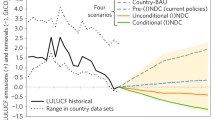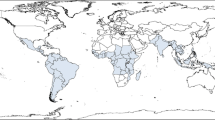Abstract
A high risk of overestimating emission reductions would be detrimental to the credibility of forest mitigation. But high-quality information on uncertainties in measuring emissions from forests is hard to obtain because of frequent shortcomings in uncertainty analyses. This paper aims to gauge what precision is achievable by examining data from several contexts (including data from 18 countries that have proposed jurisdictional mitigation programmes to the Forest Carbon Partnership Facility Carbon Fund). Countries reported random uncertainties in measuring forest carbon density (mostly 5–15% of the mean at the 90% confidence level), forest areas and their changes (mostly 0–20% for forest loss and forest degradation and 10–40% for forest gain), and greenhouse gas emissions (mostly 10–30%). It follows that uncertainties may be substantial in estimating emission reductions from forests and land-use change, and that these uncertainties entail significant risks of overestimation. I propose discount factors (between 9 and 44%) to conservatively adjust emission reduction estimates and reduce the overestimation risk. The paper concludes by pointing out that uncertainties are much lower for aggregate emission reductions of several programmes than they are for individual programmes. Discounting individual programmes’ emission reductions could therefore lead to understating the mitigation contribution that forests deliver.









Similar content being viewed by others
References
ART Secretariat (2020) The REDD+ Environmental Excellence Standard (TREES). Architecture for REDD+ Transactions Program, Washington, D.C.
Chagas T, Galt H, Lee D, Neeff T, Streck C (2020) A close look at the quality of REDD + carbon credits [WWW document]. URL https://www.climatefocus.com/publications/close-look-quality-redd-carbon-credits. Accessed 7.1.20
FAO (2019) From reference levels to results reporting: REDD+ under the UNFCCC - 2019 update. Forestry Working Paper no. 9. Food and Agriculture Organization (FAO), Rome
FCPF (2016) Carbon Fund Methodological Framework. Forest Carbon Partnership Facility (FCPF), Washington, D.C.
GFOI (2020) Integration of remote-sensing and ground-based observations for estimation of emissions and removals of greenhouse gases in forests - methods and guidance from the global forest observations initiative, 3.0. Ed. global forest observations initiative (GFOI), Rome
Goetz SJ, Hansen M, Houghton RA, Walker W, Laporte N, Busch J (2015) Measurement and monitoring needs, capabilities and potential for addressing reduced emissions from deforestation and forest degradation under REDD+. Environ Res Lett 10. https://doi.org/10.1088/1748-9326/10/12/123001
Grassi G, Monni S, Federici S, Achard F, Mollicone D (2008) Applying the conservativeness principle to REDD to deal with the uncertainties of the estimates. Environ Res Lett 3:035005. https://doi.org/10.1088/1748-9326/3/3/035005
Grassi G, Federici S, Achard F (2013) Implementing conservativeness in REDD+ is realistic and useful to address the most uncertain estimates. Clim Chang 119:269–275. https://doi.org/10.1007/s10584-013-0780-x
IPCC (2000) Good Practice Guidance and Uncertainty Management in National Greenhouse Gas Inventories. The Intergovernmental Panel on Climate Change (IPCC), Geneva
IPCC (2019) 2019 Refinement to the 2006 IPCC Guidelines for National Greenhouse Gas Inventories. The Intergovernmental Panel on Climate Change (IPCC), Geneva
Köhl M, Baldauf T, Plugge D, Krug J (2009) Reduced emissions from deforestation and forest degradation (REDD): a climate change mitigation strategy on a critical track. Carbon Balance Manag 4:1–10. https://doi.org/10.1186/1750-0680-4-10
Lusiana B, van Noordwijk M, Johana F, Galudra G, Suyanto S, Cadisch G (2014) Implications of uncertainty and scale in carbon emission estimates on locally appropriate designs to reduce emissions from deforestation and degradation (REDD+). Mitig Adapt Strateg Glob Chang 19:757–772. https://doi.org/10.1007/s11027-013-9501-z
Morton DC, Sales MH, Souza CM, Griscom B (2011) Historic emissions from deforestation and forest degradation in Mato Grosso, Brazil: (1) source data uncertainties. Carbon Balance Manag 6:11–13. https://doi.org/10.1186/1750-0680-6-18
Neeff T, Lee D (2018) Lessons learned for REDD+ from evaluations of GHG statements. Global Forest Observations Initiative (GFOI), Rome
Neeff T, Piazza M (2019) Developing forest monitoring capacity – progress achieved and gaps remaining after ten years. For Policy Econ 101:88–95. https://doi.org/10.1016/j.forpol.2018.10.013
Neeff T, van der Linden M, Herrick MD (2020) Carbon quantification choices. World Bank, Washington, D.C.
Pelletier J, Ramankutty N, Potvin C (2011) Diagnosing the uncertainty and detectability of emission reductions for REDD + under current capabilities: an example for Panama. Environ Res Lett 6. https://doi.org/10.1088/1748-9326/6/2/024005
Pelletier J, Martin D, Potvin C (2013) REDD+ emissions estimation and reporting: dealing with uncertainty. Environ Res Lett 8. https://doi.org/10.1088/1748-9326/8/3/034009
Pelletier J, Busch J, Potvin C (2015) Addressing uncertainty upstream or downstream of accounting for emissions reductions from deforestation and forest degradation. Clim Chang 130:635–648. https://doi.org/10.1007/s10584-015-1352-z
Plugge D, Baldauf T, Köhl M (2013) The global climate change mitigation strategy REDD: monitoring costs and uncertainties jeopardize economic benefits. Clim Chang 119:247–259. https://doi.org/10.1007/s10584-012-0524-3
Romijn E, Lantican CB, Herold M, Lindquist E, Ochieng R, Wijaya A, Murdiyarso D, Verchot L (2015) Assessing change in national forest monitoring capacities of 99 tropical countries. For Ecol Manag 352:109–123. https://doi.org/10.1016/j.foreco.2015.06.003
UNFCCC (2001) Decision 2-19/CP.7. The Marrakesh Accords. United Nations Framework Convention on Climate Change (UNFCCC), Bonn
UNFCCC (2003) Decision 20/CP.9. Technical guidance on methodologies for adjustments under article 5, paragraph 2, of the Kyoto protocol. United Nations Framework Convention on Climate Change (UNFCCC), Bonn
UNFCCC (2008) CDM – Meth Panel. In: Thirty-second meeting report annex 14. United Nations Framework Convention on Climate Change (UNFCCC), Bonn
UNFCCC (2010) Decision 1/CP.16. Cancun Agreements. United Nations Framework Convention on Climate Change (UNFCCC), Bonn
UNFCCC (2013) Decision 9-15/CP.19. Warsaw Framework for REDD-plus. United Nations Framework Convention on Climate Change (UNFCCC), Bonn
Verra (2019) VCS Standard v4.0. Verra, Washington, D.C.
Watson C, Mourato S, Milner-Gulland EJ (2013) Uncertain emission reductions from forest conservation: REDD in the Bale mountains, Ethiopia. Ecol Soc 18. https://doi.org/10.5751/ES-05670-180306
World Bank (n.d.) Forest Carbon Partnership Facility [WWW document]. Webpage. URL https://www.forestcarbonpartnership.org/. Accessed 3.22.19
Yanai RD, Wayson C, Lee D, Espejo AB, Campbell J, Green MB, Zukswert JM, Yoffe SB, Aukema JE, Lister A, Kirchner JW, Garmarra JGP (2020) Improving uncertainty in forest carbon accounting for REDD + mitigation efforts. Environ Res Lett 15. https://doi.org/10.1088/1748-9326/abb96f
Acknowledgements
Several experts have been available to me for technical discussions that have helped improve my thinking: Andrés B. Espejo, Cecilia Simon, Donna Lee, Javier García G., Lucio Pedroni, Marco van der Linden, Marieke Sandker, Manuel Estrada P., Sandro Federici, and Timothy Pearson. I am indebted to Ruth D. Yanai and one anonymous reviewer who have provided valuable feedback on the manuscript.
Availability of data and material
All data and material are publicly available, and sources are referenced.
Code availability
No code was required to process data for this research.
Author information
Authors and Affiliations
Contributions
All aspects of the research were conducted by the main author.
Ethics declarations
Ethics approval
Not applicable.
Consent to participate
Not applicable.
Consent for publication
Not applicable.
Conflict of interest
I have no financial interests to declare. This research was conducted approximately since 2017 when working on a series of consultancies for several organizations active in the field: The United Nation’s Food and Agriculture Organization (FAO), the World Bank, Winrock International, and Verra, which operates the Verified Carbon Standard. All of these assignments are now concluded.
Additional information
Publisher’s note
Springer Nature remains neutral with regard to jurisdictional claims in published maps and institutional affiliations.
Rights and permissions
About this article
Cite this article
Neeff, T. What is the risk of overestimating emission reductions from forests – and what can be done about it?. Climatic Change 166, 26 (2021). https://doi.org/10.1007/s10584-021-03079-z
Received:
Accepted:
Published:
DOI: https://doi.org/10.1007/s10584-021-03079-z




